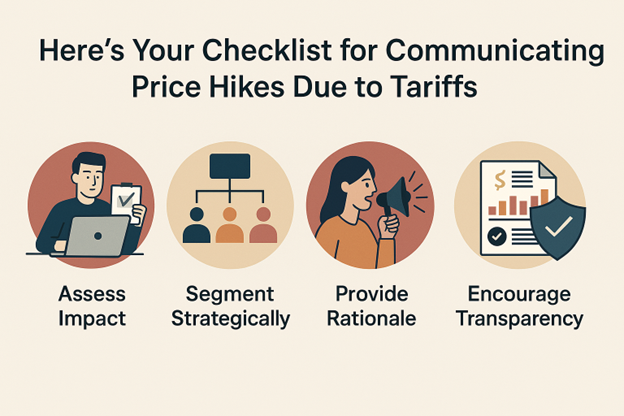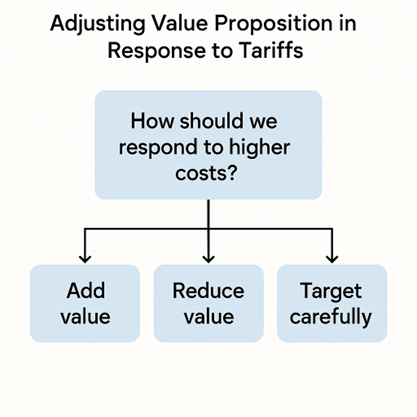When tariffs or external cost surges hit, companies are faced with one of the toughest challenges in marketing and pricing: what to do when your costs go up, but your value hasn’t.
You haven’t added features. You haven’t expanded service. The product is the same as it was yesterday—only now, it’s more expensive to deliver.
So how do you raise prices without alienating customers, eroding trust, or shrinking your business?
Step 1: Understand Where You Stand Relative to Competitors
Tariffs tend to hit whole sectors at once. That means your competitors are likely facing similar cost pressures. You’re not at a pricing disadvantage—but you may still be at a value-perception disadvantage if you handle the situation poorly.
Start by assessing:
- Is your supply chain more or less impacted than your competitors’?
- Are you a domestic producer with less exposure, potentially creating a pricing advantage?
- Can you hold or strategically raise prices and still appear relatively more affordable?
If you’re one of the few players less affected, this may be an opportunity to gain share—by holding prices steady or being transparent about modest increases. For example, if you produce wine from California, you may have an advantage over imported wines.
But if you’re on the wrong side of the cost equation? That’s where strategy becomes essential.
Step 2: Segment—and Tailor—Your Value Proposition
The worst possible move? Raising prices uniformly across all customers. This is the equivalent of pricing by averages—one of the surest ways to lose relevance in today’s market.
Instead, return to a needs-based segmentation model. Ask:
- What do different customer segments truly value?
- What elements of your offering matter most to each group?
- Where might you add small, high-value benefits to justify a price increase—or remove low-impact services without harming perceived value?
Over the years, we’ve used segmentation models to help clients navigate pricing challenges like these—tailoring value propositions and pricing strategies to align with what different segments truly care about.
Now, with the support of our ScoutTM AI system, we’re able to help companies develop these strategies even faster—with deeper, data-informed insight into customer priorities across segments. The key: one size fits none. Strategic segmentation enables pricing and value decisions that feel tailored—and fair.
Step 3: Communicate with Transparency and Agility
The concept of a tariff surcharge—clearly labeled on an invoice—is gaining traction among companies like Caterpillar and Honeywell. Why? Because transparency builds trust.
In B2B, where long-term relationships matter, this kind of openness:
- Clarifies that the increase is external, not opportunistic
- Gives sales teams a story to tell that makes sense
- Allows customers to anticipate and plan for volatility
Some companies may even choose to partially absorb increases—a bold but strategic move when the goal is to protect long-term share or loyalty.
The key is consistency across your communication:
- Align strategy, finance, and sales on the approach
- Train sales teams with clear messaging tailored to each segment
- Consider adding tariff line items to receipts or invoices, just like tax—making it visible and understandable
Step 4: Reinforce Value in New Ways
If you must raise prices, make sure customers understand the ongoing value they’re getting. This is the time to sharpen your value proposition:
- Highlight your efficiency, customer service, reliability
- Emphasize your ability to remain a consistent partner through uncertainty
- Communicate your strategic priorities—and how they benefit the customer
For some companies, this is also an opportunity to reassess packaging, service levels, or channel models. What are you offering that’s not essential to all customers? Where can you deliver more value without more cost?
Step 5: Prepare for Demand Volatility—and Tighten Your Plan
Let’s be honest: tariff-driven cost hikes can impact demand. Customers will react differently. Some may delay purchases. Some may look for substitutes. Others may challenge the price increase outright.
That’s why your strategy must be paired with financial alignment and operational flexibility:
- Work closely with finance to model different cost/price scenarios.
- Monitor customer behavior changes early and often.
- Prepare your sales and service teams to adjust, defend, and explain as needed.
In some sectors, this may be a temporary storm. In others, it may signal a longer-term change. Either way, agility matters more than ever.
Your Strategic Checklist for Tariff Response
✅ Assess competitor exposure—are you better or worse off?
✅ Segment customers by needs—tailor value and pricing accordingly.
✅ Communicate transparently—consider tariff surcharges and clear messaging.
✅ Sharpen and reinforce value—highlight what makes you worth the price.
✅ Prepare for volatility your sales teams—coordinate across finance & operations, equip the sales team to handle objections and build trust.
Pricing is always hard. But pricing when your costs rise and your value hasn’t? That takes strategy.
It’s not about finding the perfect number. It’s about finding the right story for each segment, backed by clarity, confidence, and customer focus.
Because how you handle this now could determine your position long after the tariffs fade.

 Mary Abbazia
Mary Abbazia Tom Spitale
Tom Spitale Sean Welham
Sean Welham

